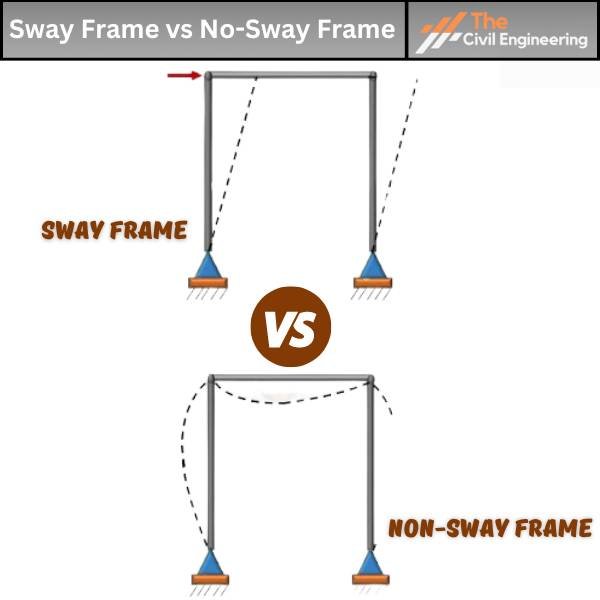In this article, we are discussing the sway and non-sway frame.

1. What is Frame?
The frame or framed structure is composed of several rods or bars jointed together in a particular fashion/design; these bars are called the members. A member under compression is known as a Strut and under tension is known as a Tie.
Some assumptions for the perfect frame are:
a. All members are pin jointed.
b. The frames are jointed at the joints only.
c. Member’s self-weight is neglected.
2. Sway Frame
The frame in which longitudinal deflection takes place when the horizontal load is applied is known as a sway frame.
Eccentric loading, unsymmetrical EI, unequal vertical members, and unsymmetrical supports are the reasons behind the swaying of frames.
When the loading is not done at the centre; sway takes place (i.e. the structure sway towards the less load side).
It is a type of an unbraced frame.
3. Non – Sway Frame
The frame in which longitudinal deflection is restrained by supports when the horizontal load is applied is known as a non-sway frame.
To be non-sway; the frame should satisfy the following conditions when cut from the centre into 2 pieces;
a. The loading should be symmetrical.
b. Given EI should be symmetrical.
c. Vertical length of members should be equal.
d. There should be symmetrical supports.
If the frame doesn’t satisfy all these 4 conditions, then the frame is said to be sway.
It is a type of a braced frame.
4. Difference Between Sway & Non-Sway Frame
| S.N. | Sway | Non-Sway |
| 1. | They lack adequate stiffness against horizontal loads/forces. | They have sufficient stiffness to tackle with horizontal forces. |
| 2. | Loading is generally asymmetrical. But in some cases, it may be symmetrical. | Loading is symmetrical. |
| 3. | Changes in the position of joints take place due to lateral deflection. | Changes in the position of joints do not take place. |
| 4. | The second-order analysis is done. | The first-order analysis is done. |
| 5. | They may or may not have symmetrical EI, vertical lengths, or supports. | They compulsorily should have symmetrical EI, vertical lengths, or supports. |
| 6. | They are less stable. | They are more stable. |
| 7. | It is a type of an unbraced frame. | It is a type of a braced frame. |
| Read also: Difference Between Lime and Cement |
5. Conclusion
In practical life, a non-sway frame is widely used over the sway because of the stability of the non-sway frame.
